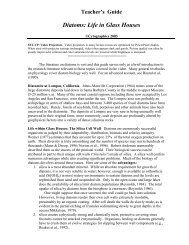Sepsis Syndrome: Bacterial Endotoxin - Sinauer Associates
Sepsis Syndrome: Bacterial Endotoxin - Sinauer Associates
Sepsis Syndrome: Bacterial Endotoxin - Sinauer Associates
Create successful ePaper yourself
Turn your PDF publications into a flip-book with our unique Google optimized e-Paper software.
9-3 <strong>Sepsis</strong> <strong>Syndrome</strong>: <strong>Bacterial</strong> <strong>Endotoxin</strong><br />
(a) bacterial cell surface<br />
(b)<br />
(c)<br />
lipopolysaccharide<br />
peptidoglycan<br />
lipoprotein<br />
lipopolysaccharide<br />
core<br />
polysaccharide<br />
GlcN<br />
variable<br />
O-oligosaccharide<br />
lipid A<br />
lipid A<br />
O<br />
OH<br />
O<br />
P<br />
O HO O O<br />
O O<br />
OH O O<br />
P<br />
NH<br />
NH O<br />
O<br />
OH<br />
O O<br />
O O<br />
14<br />
membrane<br />
proteins<br />
O<br />
14<br />
O<br />
O<br />
O<br />
porin<br />
GlcN<br />
OH<br />
14 12 14 14<br />
outer<br />
membrane<br />
periplasm<br />
plasma<br />
membrane<br />
Figure 9-6 Structure of LPS (a) Simplified<br />
diagram of Gram-negative bacterial cell surface<br />
showing LPS and some other major features.<br />
Approximately 3 ¥ 10 6 LPS molecules decorate<br />
75% of the surface of Gram-negative bacteria.<br />
(b) The LPS molecule consists of an outer O-<br />
specific oligosaccharide that is highly variable<br />
among different species, a conserved inner<br />
core, and a lipid—lipid A—that forms part<br />
of the bacterial outer membrane. (c) Lipid A<br />
is a phosphoglycolipid consisting of a core<br />
hexosamine disaccharide with ester- and<br />
amide-linked acylated fatty acid tails arranged<br />
in either asymmetric or symmetric arrays that<br />
anchor the structure in the membrane. The<br />
asymmetric structure of E. coli lipid A is<br />
shown here. The numbers refer to the<br />
number of carbon atoms in the tail.<br />
OH<br />
<strong>Sepsis</strong> syndrome is a systemic response to invasive pathogens<br />
<strong>Sepsis</strong> syndrome, or sepsis, is an adverse systemic response to infection that includes fever,<br />
rapid heartbeat and respiration, low blood pressure and organ dysfunction associated with<br />
compromised circulation. Approximately 250,000–750,000 cases of sepsis occur annually in<br />
the United States of America, with mortality ranging from 20% to 50% overall and as high as<br />
90% when shock develops. <strong>Sepsis</strong> can occur through infection with Gram-positive bacteria<br />
and even fungi and viruses, or as a consequence of secreted toxins, which we discuss in the next<br />
section. However, the sepsis syndrome occurs commonly in response to lipopolysaccharide<br />
(LPS) from Gram-negative bacteria, which will be illustrated here.<br />
Lipopolysaccharide recognition occurs via the innate immune system<br />
LPS is a major constituent of Gram-negative bacterial cell walls (see section 3-0) and is essential<br />
for membrane integrity. The portion of LPS that causes shock is the innermost and most highly<br />
conserved phosphoglycolipid, lipid A (Figure 9-6), which acts by potently inducing inflammatory<br />
responses that are life-threatening when systemic (see below), and is known as bacterial<br />
endotoxin. Multicellular organisms from horseshoe crabs and fruit flies to humans have<br />
evolved proteins specialized for the recognition of LPS. These proteins are found both on the<br />
surface of phagocytic cells and as soluble proteins in blood.<br />
LPS is removed by macrophages through scavenger receptors (for example, SR-A) that are<br />
highly expressed in the liver and are thus positioned to remove LPS from portal blood draining<br />
the intestines, and by neutrophils through the primary granule protein, bactericidal permeabilityincreasing<br />
protein (BPI), which is toxic to Gram-negative bacteria (see section 3-9). The<br />
homologous LPS-binding protein, LBP, transfers LPS to membrane-bound or soluble CD14,<br />
enabling interactions with Toll-like receptors (TLRs) on the phagocyte membrane (see section<br />
3-10), and to high-density lipoprotein (HDL) particles for removal. In mice and humans the<br />
LPS receptor includes CD14, an LPS-interacting moiety, TLR4, the signal transducing element,<br />
and MD-2, a small extracellular protein tightly bound to TLR4 (see Figure 3-34). Mice<br />
deficient in any of the LPS receptor components are more susceptible to Gram-negative<br />
bacterial infection but, at the same time, are less susceptible to the sepsis syndrome.<br />
<strong>Sepsis</strong> results from the activation of lipopolysaccharide-responsive<br />
cells in the bloodstream<br />
TLRs have a lethal function in the septic shock syndrome. The physiological function of<br />
signaling through phagocyte TLRs is to induce the release of the cytokines TNF, IL-1, IL-6,<br />
IL-8 and IL-12 and trigger the inflammatory response, which is critical to containing bacterial<br />
infection in the tissues. However, if infection disseminates in the blood, the widespread activation<br />
of phagocytes in the bloodstream is catastrophic.<br />
Humans injected with purified LPS develop a cytokine cascade in the serum (Figure 9-7). The<br />
early cytokine response (TNF, IL-6 and IL-8) coincides with the onset of fever and the activation<br />
of blood neutrophils, monocytes and lymphocytes. A subsequent increase in the numbers of<br />
circulating neutrophils, or neutrophilia, is driven by effects of colony stimulating factors, such<br />
as G-CSF, whereas the decreased numbers of circulating lymphocytes and monocytes, designated<br />
lymphopenia and monocytopenia, is sustained by their activation-induced exit and retention<br />
in peripheral sites. This is followed by a pituitary response and a regulatory or antiinflammatory<br />
response (see section 3-15).<br />
Definitions<br />
endotoxin: (of bacteria) a non-secreted toxin inherent<br />
in the cell membrane and that induces strong innate<br />
inflammatory responses that can be fatal when systemic.<br />
LD 50: the dose at which 50% of treated individuals<br />
die.<br />
lymphopenia: a decrease in the numbers of circulating<br />
lymphocytes.<br />
monocytopenia: a decrease in the numbers of circulating<br />
monocytes.<br />
neutrophilia: a rise in the number of circulating<br />
neutrophils.<br />
protein C: a vitamin K-dependent plasma serine<br />
protease that is synthesized in liver and activated by<br />
a complex of thrombin bound to thrombomodulin on<br />
membranes and that then cleaves coagulant factors<br />
VIIIa and Va, inactivating them.<br />
232 Chapter 9 The Immune Response to <strong>Bacterial</strong> Infection<br />
©2007 New Science Press Ltd
<strong>Sepsis</strong> <strong>Syndrome</strong>: <strong>Bacterial</strong> <strong>Endotoxin</strong> 9-3<br />
Figure 9-7 Time course of sepsis The clinical manifestations of sepsis are shown above the successive<br />
waves of the serum cytokine cascade. (Cytokine concentrations are not shown to scale.) In humans<br />
injected with purified LPS, TNF rises almost immediately and peaks at 1.5 h; the sharp decline of TNF<br />
may be due to modulation by its soluble receptor sTNFR. A second wave of cytokines that peaks at 3 h<br />
activates the acute-phase response in the liver and the systemic pituitary response (via IL-6 and IL-1)<br />
and the activation and chemotaxis of neutrophils (via IL-6, IL-8 and G-CSF). Neutrophil activation<br />
results in the release of lactoferrin from neutrophil secondary granules; the activation of endothelial<br />
procoagulants is shown by the rise of tissue plasminogen activator (t-PA). Pituitary-derived adrenocorticotropic<br />
hormone (ACTH) and migration inhibition factor (MIF) peak at 5 h and coincide with peak<br />
levels of the regulatory cytokines IL-Ra and IL-10 that counteract the release or activity of inflammatory<br />
cytokines. Diffuse endothelial activation is shown by the appearance of soluble E-selectin that peaks at<br />
about 8 h and remains elevated for several days.<br />
neutrophils<br />
heart rate<br />
temperature<br />
monocytes<br />
lymphocytes<br />
0 1 2 3 4 5 6<br />
Inflammation leads to widespread endothelial cell activation and organ<br />
dysfunction<br />
Cytokine production in the bloodstream results in widespread endothelial cell activation, with<br />
expression of adhesion molecules, activation of the coagulation cascade and the production of<br />
chemokines and cytokines by the endothelial cells themselves, with consequent amplification<br />
of the inflammatory cascade. The adhesion and activation of circulating neutrophils at the<br />
endothelium results in both oxidative and elastase-mediated damage, resulting in the loss of<br />
vascular integrity and failure to maintain adequate blood pressure. TNF and IL-1 also depress<br />
myocardial function directly. Refractory shock, with leakage of edema fluid, and the failure of<br />
organs with large capillary beds, such as the lung and kidney, leads to death.<br />
Levels of circulating TNF, IL-6, IL-1 and LPS are directly correlated with the probability of<br />
death in humans with sepsis. Despite this, anti-LPS and anti-TNF antibodies, soluble TNF<br />
receptors, IL-1Ra and corticosteroids have all failed to alter the outcome of septic shock.<br />
Greater success has been achieved with activated protein C, an antithrombic, antiinflammatory<br />
serine protease activated by thrombin and consumed during sepsis. Levels of activated<br />
protein C and antithrombin III are inversely correlated with the probability of death from<br />
sepsis, and replacement of activated protein C can reduce the relative risk of death during<br />
severe sepsis by almost 20%.<br />
Animal models have helped clarify mechanisms of sepsis<br />
Two widely used models are commonly referred to as the high-dose and low-dose models<br />
(Figure 9-8). High-dose LPS challenge involves injection of mice intraperitoneally or intravenously<br />
with doses typically between 25 and 100 mg per animal. The LD 50 approximates 150 mg, with<br />
death occurring in about 35 hours. Mortality is due to proinflammatory cytokines and<br />
widespread endothelial cell injury. Mice with defects in neutrophil adhesion or activation<br />
demonstrate a higher LD 50 in this assay. The low-dose LPS model relies on concurrent<br />
administration (from 1 h before to 4 h after) of D-galactosamine, a potent and specific<br />
inhibitor of hepatic macromolecular synthesis. Mice given 300 mg galactosamine/kg (typically<br />
20 mg) have an LD 50 of 0.5 ng LPS, with death occurring in about 7 h. In the low-dose model,<br />
death is due to massive hepatic necrosis in response to LPS by a process dependent upon TNF<br />
and IFN-g. Mice deficient in the production or recognition of these cytokines demonstrate a<br />
higher LD 50 in the low-dose model. Mice deficient in the clearance or recognition of LPS itself<br />
demonstrate an altered LD 50 in both models.<br />
0 1 2 3 4 5 6 7 8<br />
time (hours)<br />
LPS TNF<br />
sTNFR<br />
IL6, IL-8, G-CSF, lactoferrin, t-PA<br />
ACTH, MIF, IL-IRa, IL-10<br />
sE-selectin<br />
Susceptibility to LPS Toxicity in Gene<br />
Knockout Mice<br />
Defect<br />
LPS recognition<br />
phagocyte function<br />
inflammation<br />
Protein High LPS Low LPS/D-Gal<br />
CD14<br />
LBP<br />
TLR4<br />
MD-2<br />
MyD88<br />
SR-A<br />
Hck/Fgr<br />
ICAM-1<br />
L-selectin<br />
GM-CSF<br />
TNFR1<br />
TNFR2<br />
IL-1Ra<br />
IL-1β<br />
IFN-γR<br />
caspase 1<br />
decreased<br />
no change<br />
decreased<br />
decreased<br />
decreased<br />
enhanced<br />
decreased<br />
decreased<br />
decreased<br />
decreased<br />
no change<br />
no change<br />
enhanced<br />
no change<br />
decreased<br />
decreased<br />
decreased<br />
decreased<br />
decreased<br />
decreased<br />
decreased<br />
not done<br />
no change<br />
no change<br />
not done<br />
not done<br />
decreased<br />
no change<br />
not done<br />
no change<br />
decreased<br />
not done<br />
Figure 9-8 Table of susceptibility to LPS<br />
toxicity in gene knock-out mice The proteins<br />
encoded by the deleted genes are listed. SR-A is<br />
scavenger receptor A; Hck and Fgr are Src-family<br />
kinases with an essential role in integrin-mediated<br />
migration of neutrophils out of the bloodstream.<br />
D-Gal: D-galactosamine.<br />
References<br />
Arbour, N.C. et al.: TLR4 mutations are associated with<br />
endotoxin hyporesponsiveness in humans. Nat.<br />
Genet. 2000, 25:187–191.<br />
Bernard, G.R. et al.: Efficacy and safety of recombinant<br />
human activated protein C for severe sepsis. N. Engl.<br />
J. Med. 2001, 344:699–709.<br />
Casey, L.C. et al.: Plasma cytokine and endotoxin levels<br />
correlate with survival in patients with the sepsis<br />
syndrome. Ann. Intern. Med. 1993, 119:771–778.<br />
Faust, S.N. et al.: Dysfunction of endothelial protein C<br />
activation in severe meningococcal sepsis. N. Engl. J.<br />
Med. 2001, 345:408–416.<br />
Kuhns, D.B. et al.: Increased circulating cytokines,<br />
cytokine antagonists, and E-selectin after intravenous<br />
administration of endotoxin in humans. J. Infect. Dis.<br />
1995, 171:145–152.<br />
Mira, J.-P. et al.: Association of TNF2, a TNF-a promoter<br />
polymorphism, with septic shock susceptibility and<br />
mortality: a multicenter study. JAMA 1999,<br />
282:561–568.<br />
Suffredini, A.F.: Promotion and subsequent inhibition<br />
of plasminogen activation after administration of<br />
intravenous endotoxin to normal subjects. N. Engl. J.<br />
Med. 1989, 320:1165–1172.<br />
van der Poll, T. et al.: Activation of coagulation after<br />
administration of tumor necrosis factor to normal<br />
subjects. N. Engl. J. Med. 1990, 322:1622–1627.<br />
©2007 New Science Press Ltd<br />
The Immune Response to <strong>Bacterial</strong> Infection Chapter 9 233












